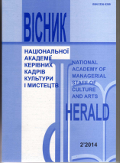REMARKABILITY AS AN ESSENCE OF THE MODERN ARTISTIC WORLD PICTURE
DOI:
https://doi.org/10.32461/2226-3209.2.2014.137931Keywords:
culture, personality, consciousness, subconsciousness, artistic world picture, beingAbstract
On the basis of multiaspected analysis of the artistic culture displays an author points its key directions, for example: aestheticization, unification, violation of a balance between elite and mass in the culture, and also influence of advertising, television and Internet on forming of the artistic world picture.
Many modern researchers note culture being reduced to the text, which is, in its essence, reducing to the sign. Artistic world view is more and more based on signs, not on images and symbols as it was in the previous ages. And signs, as we know, don’t have any transcendental or metaphysical depths symbols include. That’s why artistic world view is moving from the vertical section and multidimensional space to the one-dimensional space, which can be compared to a personality moving in the same direction.
Main thing about the one-dimensionality of culture and, consequently, artistic world view is, first of all, Eurocentrism disappearance.
Eurocentric paradigm that eventually made its way into theNew World, i.e. American civilization, is tacitly considered to be culture’s main construct. Although with the huge world changes Eurocentrism starts to fade and its place is ready to be taken by completely different Asian culture paradigms.
The Modern project, called that way by a number of philosophers, started at the times of early modern period when Cartesianism was created and the famous European "ratio" standard was established. All this contributed to the tremendous project of rational understanding of the world that was a part of society structure and that era world view in general.
Any kind of avant-garde trend eventually goes into one-dimensional artistic space. It’s not only futurism’s fate. Futurism trend is just a demonstrative example. Such fate befell expressionism and many other trends that ultimately lost many of their aesthetical and practically-aesthetical functions with images and symbols loosing their mission.
Modern artistic culture, culture in general and artistic world view specifically have their strong features. These are: а) the aesthetic function, perceived by artistic world view; b) the unification of artistic world view, because artistic world view is disposed to different emotional and image clichés reproduction; c) disturbing the balance between elite and mass components of culture with mass components being more important and giving rise to the so called pop culture; d) pop culture creating new archetypes that are inserted to artistic world view as "sign" figures, which are the "sign" figures exactly, not symbolic ones. To put it another way, it creates a huge space of pop culture idols, archetypes and signs; e) the fact that artistic world view is formed with the help of new elements such as media, television and the Internet. The problem of new strata of collective unconscious becomes more firm and significant. It appears to include structures that were absent in different artistic world views of the previous ages.
Downloads
Published
Issue
Section
License
Authors who publish with this journal agree to the following terms:
1. Authors retain copyright and grant the journal right of first publication with the work simultaneously licensed under a Creative Commons Attribution License International CC-BY that allows others to share the work with an acknowledgement of the work's authorship and initial publication in this journal.
2. Authors are able to enter into separate, additional contractual arrangements for the non-exclusive distribution of the journal's published version of the work (e.g., post it to an institutional repository or publish it in a book), with an acknowledgement of its initial publication in this journal.
3. Authors are permitted and encouraged to post their work online (e.g., in institutional repositories or on their website) prior to and during the submission process, as it can lead to productive exchanges, as well as earlier and greater citation of published work (See The Effect of Open Access).


